Before he was Zapier’s CEO, Wade Foster played saxophone in a blues and jazz quartet with bassist Bryan Helmig, who would later become Zapier’s CTO. (Reminder: This is a true story.)
Wade and Bryan became fast friends after playing gigs around their hometown of Columbia, Missouri, and discovered they had a shared passion beyond music: building web apps. As Wade explained on the Indie Hackers podcast, Bryan specialized in doing “a lot more of the harder technical work” while Wade specialized in doing “a lot of the marketing, client sales-type stuff, [and] support-type stuff.”
The pair’s complementary skill sets helped them work well together as a duo, and they began taking on projects together. Then, one day, in September of 2011, Bryan messaged Wade with an idea. The rest, as they say, is history.
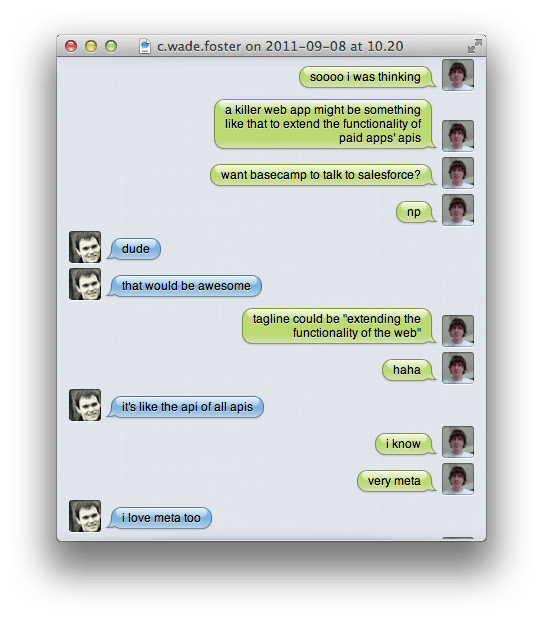
(Image Source: zapier.com/blog)
But to be clear: Zapier – which, rhymes with “happier,” in case you were wondering – wasn’t an overnight success. First, they had to recruit Bryan’s friend Mike Knoop to the team, who would go on to become Zapier’s third co-founder and CPO. Together, they built a “demo-able” version of their app in a few weeks and presented it at Columbia, Missouri’s first-ever startup competition in October 2011.
The app, which Bryan had dubbed “API Mixer,” took first place in the competition – and that’s when Zapier’s co-founders began to treat their creation as more than just a side project. They changed the name, applied to the accelerator program Y Combinator, got rejected, then applied again and got accepted. Zapier officially launched in June of 2012, offering integrations with 34 apps.
Today, Zapier has integrations with over 2,000 apps, adding 600 partners in 2019 alone (with Microsoft Teams, Google Ads, and DocuSign being a few notable mentions).
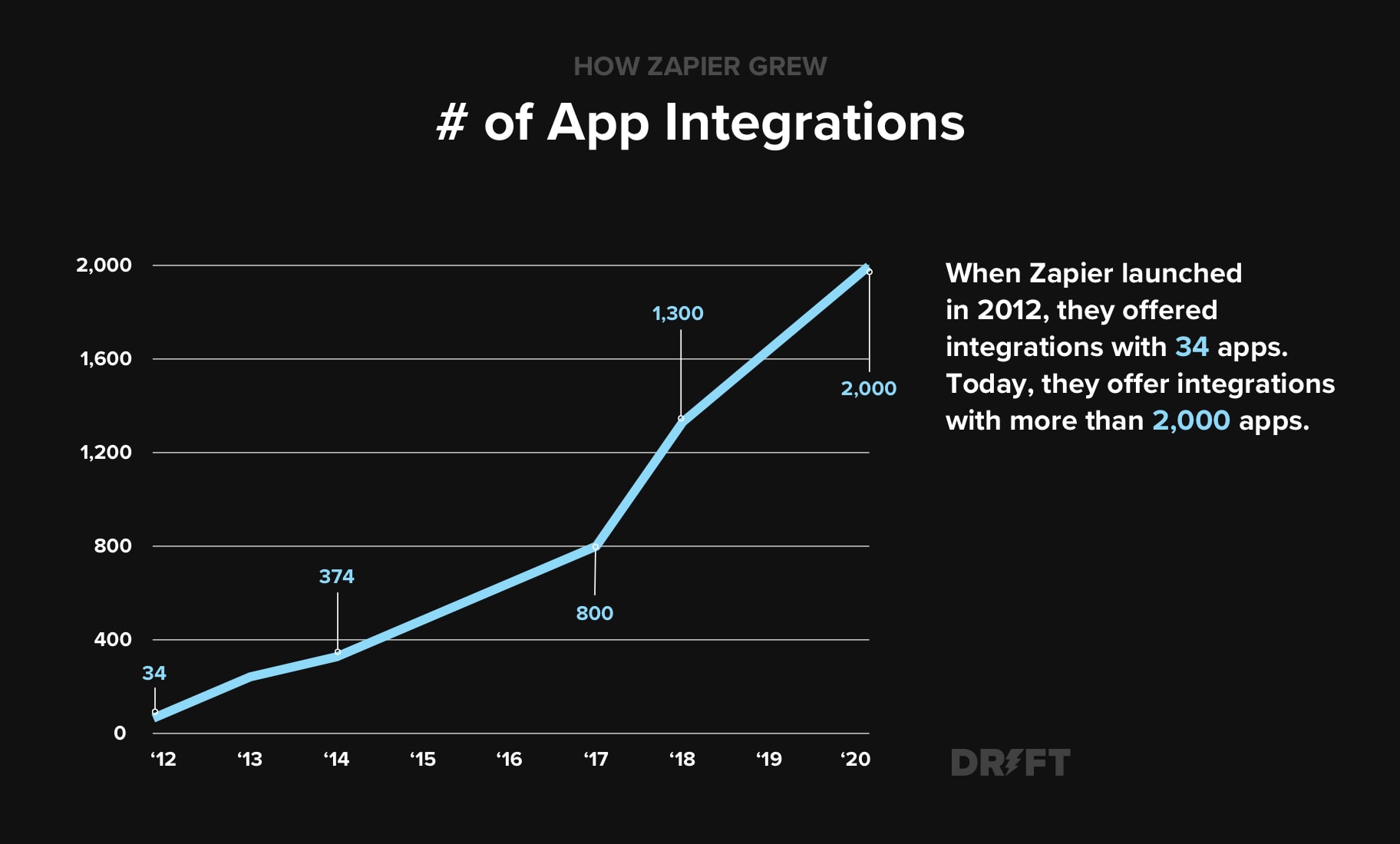
Just two years after launching – with only one round of Series A funding totaling $1.3 million – Zapier pulled off a feat that takes many companies years to achieve: profitability. And when you look at the company’s annual recurring revenue (the revenue they earn from product subscriptions in a given calendar year) it’s easy to see how that was possible. Between 2016 and 2018, Zapier’s ARR grew from approximately $10 million to more than $50 million.
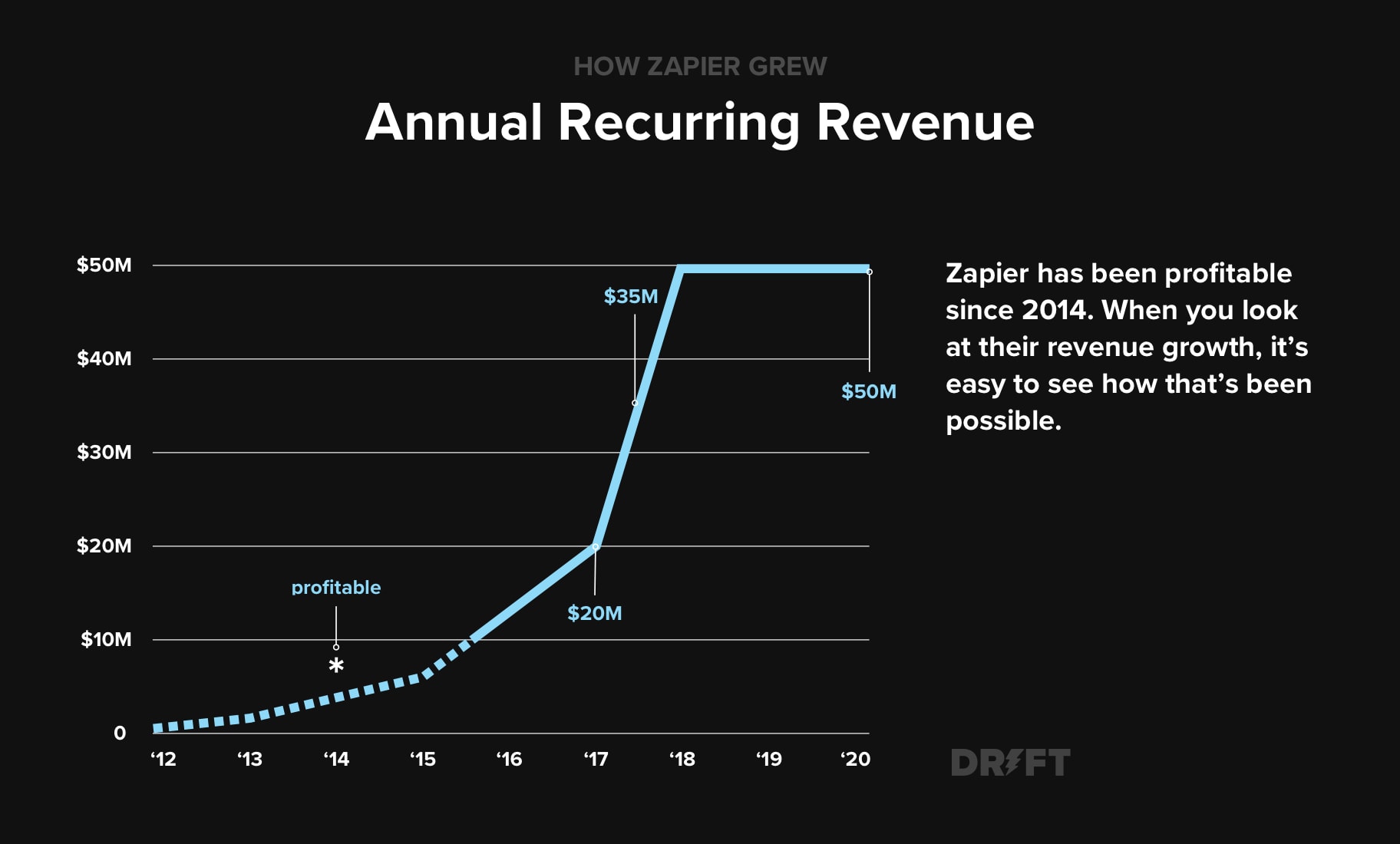
Needless to say, this growth hasn’t gone unnoticed. This year, top venture capitalists ranked the most promising private companies in enterprise tech across three categories (early-stage, mid-stage, and late-stage) based on capital raised. And for the early-stage category, Zapier once again snagged the top spot.
“Zapier returns as #1 in the Early-Stage Category. This is not surprising, as Zapier, a highly capital efficient company, is mid- or late-stage by metrics other than total capital raised.”
So, how did Zapier grow from a weekend project to a profitable tech powerhouse that’s pulling in tens of millions in revenue each year? And, more importantly, how can you follow their playbook and replicate their extraordinary success? Keep reading to find out.
In a rush? Here’s the tl;dr version :
- Don’t underestimate the value of building one-to-one relationships. Zapier built their user base one person at a time, focusing on individualized outreach over “spray and pray” tactics.
- Make everyone responsible for customer support. Zapier doesn’t just preach this, they practice it. Everyone at the company, regardless of role, takes a shift doing customer support.
- Stay transparent and data-driven. As a company with a fully remote workforce, Zapier is obsessed with “oversharing.” If something important needs to be shared, they share it multiple times via multiple channels.
- Make your customers the heroes of your marketing. In the early days, Zapier used their blog to document their company’s journey. Turns out that’s not what potential buyers want to read.
1. Don’t underestimate the value of building one-to-one relationships.
Wade Foster, Bryan Helmig, and Mike Knoop didn’t fit the mold of stereotypical startup founders. Wade even admitted as much in an interview with Groove:
“We’re not Stanford engineering students who worked at these awesome startups in the Valley. We’ve never been funded before. Our resumes included things like industrial engineering degrees and working in a mortgage company. We weren’t a good fit.”
Or rather, they weren’t the usual fit. But they did have a roll-up-your-sleeves work ethic that was committed to building Zapier’s customer base one person at a time. To quote Wade:
“…We can’t be the best and we can’t be the cheapest, but we can definitely care the most, and so from day one, we thought, ‘let’s get on Skype calls, let’s do things that might not scale right now, just so that we can make people really happy and really want to work with us.’ When you’re very early stage… you don’t need a thousand customers, you just need one customer or ten customers, and we were able to go from nothing to something just through this very targeted outreach.”
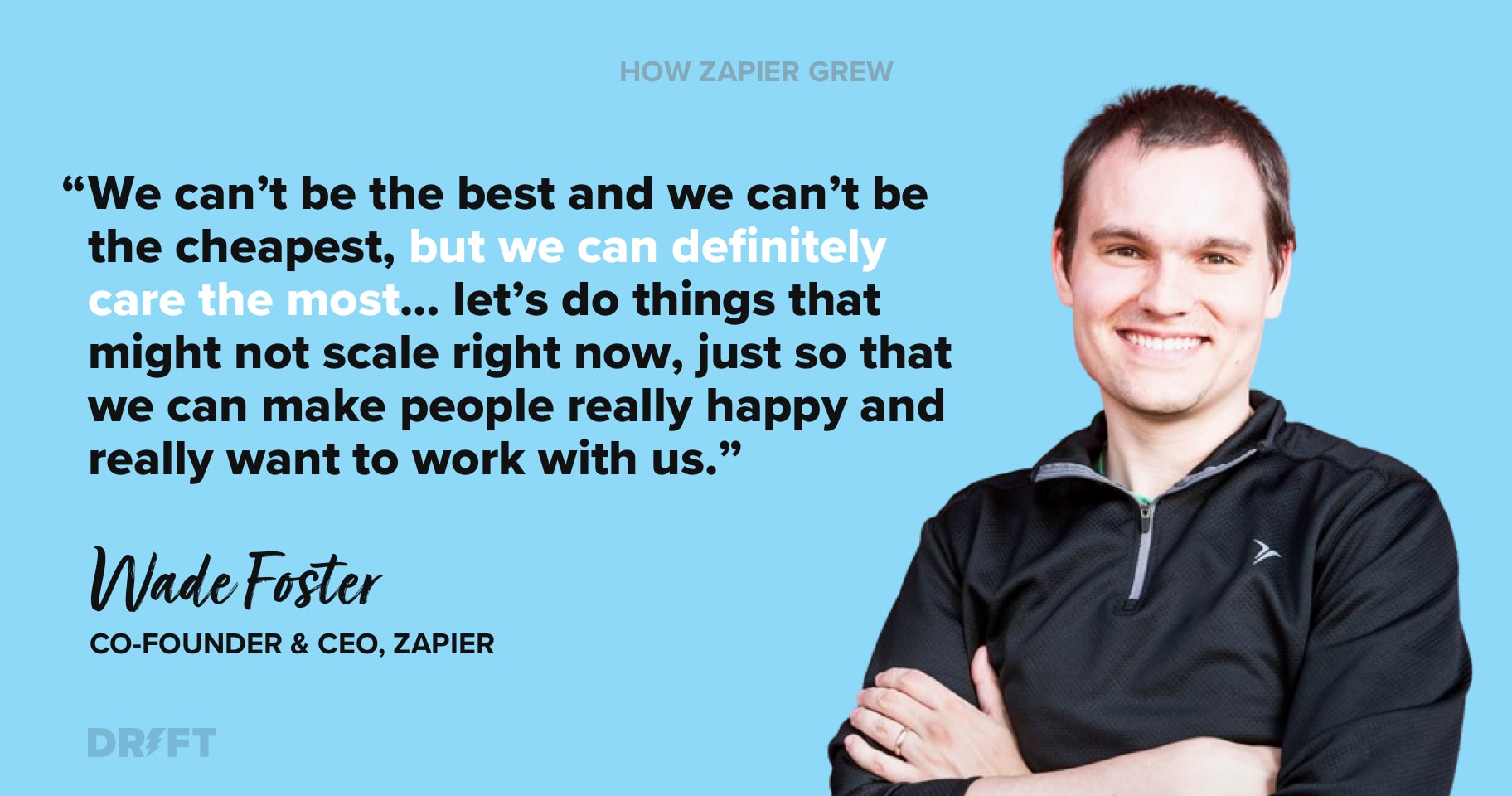
In order to attract their first beta customers, Wade would spend hours in customer forums for companies like Basecamp, Salesforce, Dropbox, and Evernote, seeking out people who were searching for (and complaining about the lack of) integrations with other tools. As Wade explained in an interview with Typeform:
“Someone would ask, ‘Why doesn’t this app have an integration with this?’ And we’d say, ‘Hey, you can use the API to build this stuff, and we can help you out.’ Each time we did this, we’d get a few new beta customers. And that’s exactly what we needed in the early days. It took us probably eight months of proactively reaching out to customers before we got our first inbound request, someone asking “Hey, how do I get my app on Zapier?”
For a company that’s dedicated to automating tasks and workflows, there’s a bit of irony in this initial bootstrap approach to customer acquisition and support. But this willingness to hop on calls and give customers personal, one-to-one attention gave Zapier an edge (even if it wasn’t scalable). While the company may not have had millions to spend on advertising, they were investing in relationships and getting invaluable feedback in the process. In this way, Zapier’s three founders were using the company’s small size to its advantage. As Wade said:
“One of the cool things that startups can do that big companies can’t is to go fishing in small ponds. There are little channels that a big company would never waste their time on… But small companies can get in there, and it actually does move the needle.”
Ultimately, when you’re an early-stage startup, you can’t be focused on how you’re going to attract your millionth customer, you need to be focused 100% on attracting your next customer. By sticking to that approach, Zapier was able to grow their user base from a handful of people they met in product forums to the 3+ million people who rely on Zapier today.
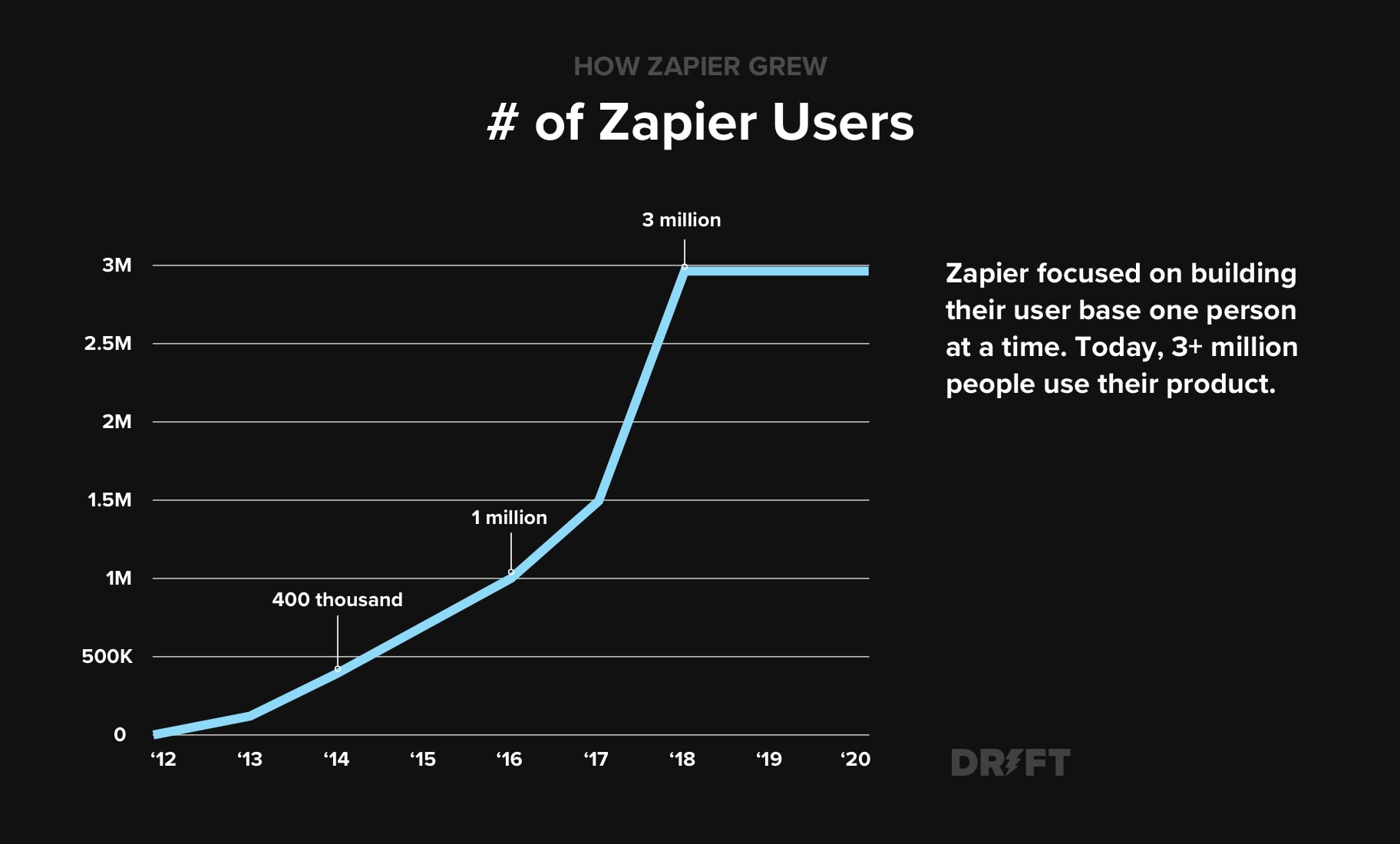
2. Make everyone responsible for customer support.
In Zapier’s early days, everyone at the company did customer support as a matter of necessity. There simply wasn’t anyone else to do it.
From the get-go, CEO Wade Foster saw the value in being as responsive and as accommodating as possible with customers. During Zapier’s beta testing phase, he would often hop on calls with customers and do his best to solve problems in real-time. Even in cases when the product malfunctioned, he made sure the overall experiences people were having with Zapier were positive. As Wade told Groove:
“When something didn’t work, of course, I felt awful, but it was a learning experience and I was sitting there on the call with them, so they knew that the issue was getting attention. If we found problems we’d fix them as quickly as we could and go right back to that customer and say, ‘Hey that problem we had on the Skype call? It’s not a problem anymore.’ That level of service for early customers surprised a lot of people.”
As Zapier grew, Wade made certain that providing stellar customer support would always remain a pillar of how the company operated – and he did that by making customer support mandatory for all employees. Regardless of what specific teams employees are on, if they work at Zapier, they have to take a shift doing customer support. To quote Wade:
“There’s one thing that everyone who works at Zapier, from developers to marketers, has to do: customer support. Everyone at Zapier spends time doing customer support. You don’t get hired and not talk with customers, that’s not a thing. If you don’t want to do customer service, go work somewhere else.”
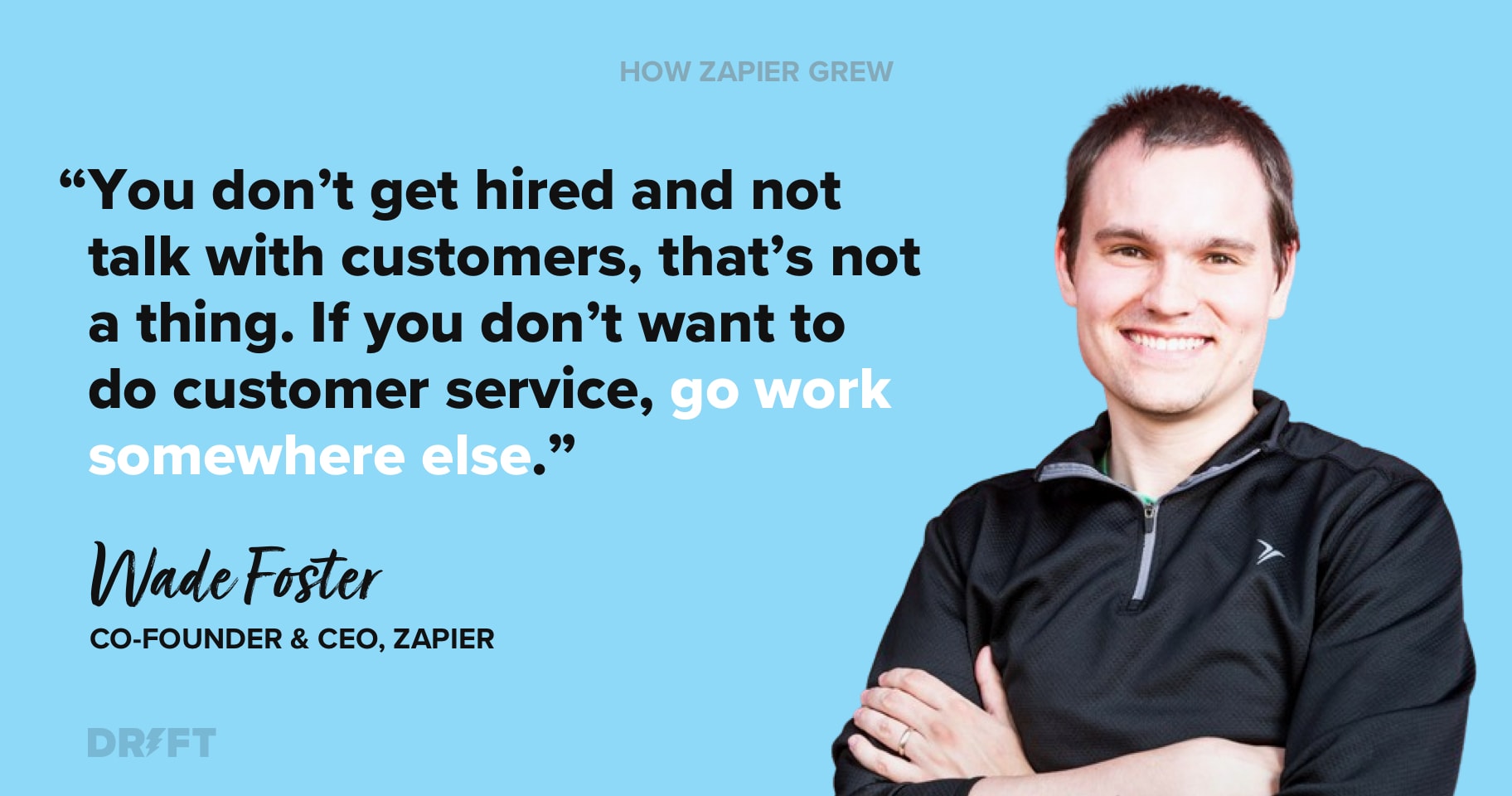
Wade found that this company-wide approach to customer support actually helps employees excel at their primary functions.
For example, when taking support shifts, engineers are able to learn first-hand about problems that customers are having with the product. They’re able to see customer frustrations as they’re unfolding. As Wade explained, that means there’s “no misinterpretation between support and the people who are building the product about what’s important in the users’ minds.”
For Zapier’s marketers, meanwhile, spending four hours each week doing support “puts them in the mind of the customer and really makes them care about the customer a lot more,” according to Wade.
Because customer support is so fundamental to Zapier’s culture, having good support chops is something they look for during the hiring process. And guess what? Even if applicants are talented, Zapier won’t hire them if they don’t have the requisite customer communication skills. To quote Wade:
“Not only does every Zapier job candidate have to be good at the job they’re being hired for, they have to be good at support, too.
In interviews we’re looking for personable people; if an engineer comes off as a great engineer but is a little bit prickly, we’re probably not gonna hire them because they’re just not going to be a good fit.
We also look at the emails they write to us. Are they being friendly, or do they come off a little short or callous? We just want people that are going to come off as being really friendly via email to our customers, so it’s something we’re paying attention to along the way.”
This “all-in” approach to customer support has clearly benefited Zapier’s bottom line. In the past year and a half, the company boosted its customer lifetime value (LTV) by 120% and maintains less than a 5% logo churn month-over-month.
3. Be transparent and data-driven.
In 2020, businesses across the globe had to rapidly shift to remote work in response to Covid-19. Companies that had been stringent in-office types suddenly had to adapt to a distributed workforce – something that Zapier is well-versed in. They’ve been fully remote since the very beginning.
Interviews with Zapier’s leadership often gravitate to the company’s work-from-home strategy. How have they been able to maintain efficiency, company culture, and collaboration when team members are dispersed across time zones?
The leading answer seems to be: transparency.
While remote work has given Zapier the opportunity to tap into a global talent pool, Foster, Helmig, and Knoop all admit that communication can be an obstacle. This is why CEO Wade Foster made it a point to bake transparency into their company culture. As he told Hacker Noon:
“Remote workers are happiest when they feel connected to the business. We kept that in mind when we developed one of our core values, which is ‘default to transparency.’
The tradeoff of having a distributed team is that you have to be disciplined at documenting decisions and major changes, so no one gets left behind. When people have accurate, well-documented information in front of them, they can make smart decisions and they can be self-starters.”
At Zapier, teams structure their work around a DACI framework, an acronym that stands for: driver, approver, consulted, and informed. It provides clarity as to who the decision-makers are for each project and the process for moving forward. Zapier also created best practices around sharing information asynchronously – the default for a diffused workforce.
While the team uses Slack for real-time communication, everything else (that may not need immediate attention, but is still important) goes into Zapier’s homegrown solution, Asynch, which Wade describes as “blog meets Reddit.”
And while Asynch was a breakthrough for helping Zapier stay organized, it’s still just a single channel. As CTO Bryan Helmig explained in an interview with You Team, in order to truly “default to transparency,” you need to be vocal across all of the channels your company is using to communicate.
“One thing we had to double down on more and more is the style we use to communicate. We really overcommunicate things because you want to repeat the most important aspects in many different channels, and in many different ways. Anything that is worth saying is worth saying a dozen times.”
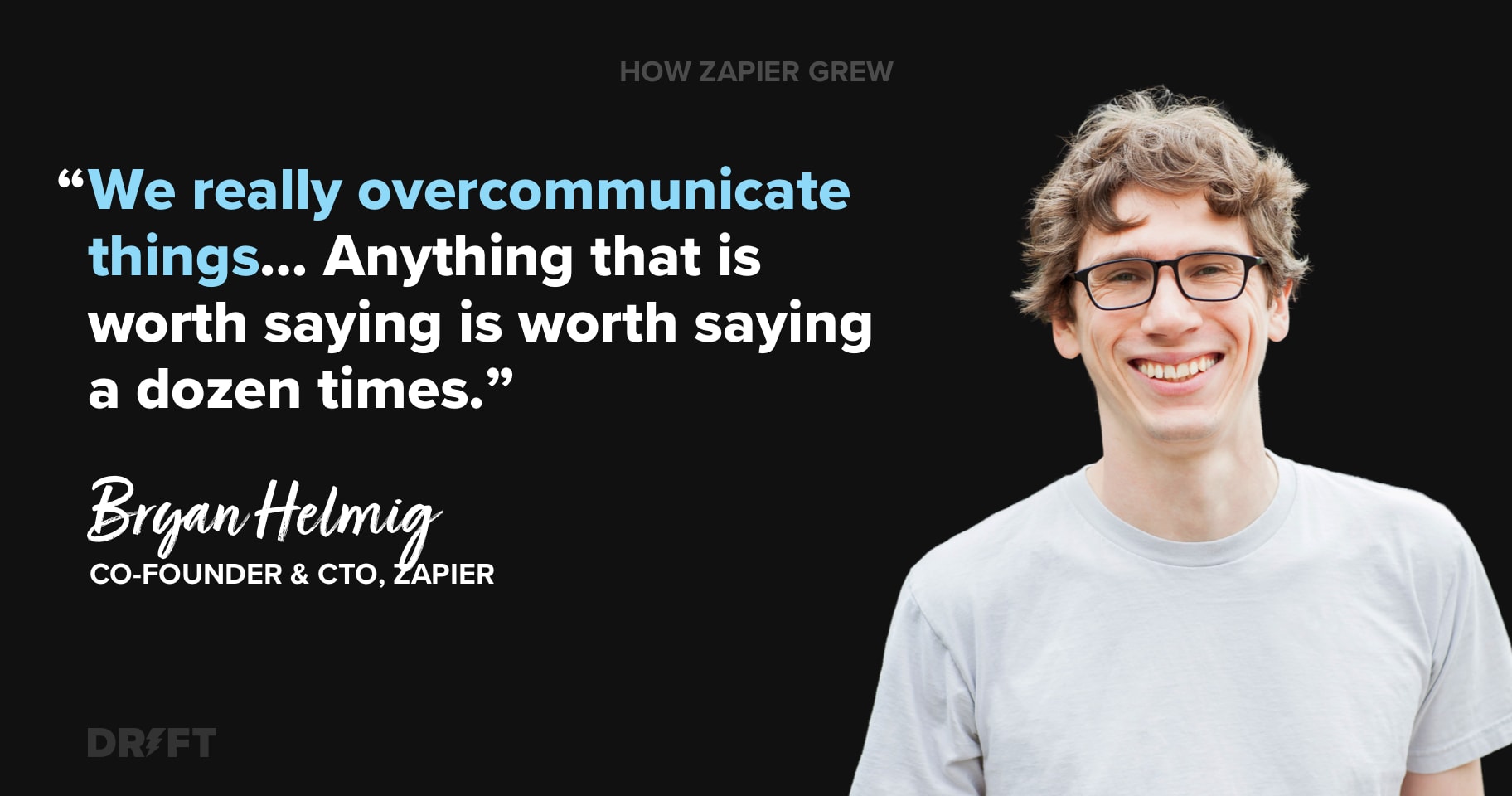
Since team members are expected to communicate across multiple channels, including asynchronous ones, Zapier employees need to be strong writers as well as strong speakers. That’s why during the interview process, Wade likes to ask himself the following questions about the candidates they’re looking at:
- “Are they the type of person who can articulate their thoughts clearly?”
- “Can they write them down?”
- “Can they talk to different types of people well?”
As Wade told Kieran Flanagan, asking those questions is “super important,” because, “being remote, you can’t always be jumping on a call. At a remote company, you need to be able to write.”
And while in the past there may have been some skepticism around remote work’s efficiency, Zapier serves as proof of concept. In an interview with Nathan Latka, Foster said that remote work has kept Zapier more data-driven, stripping away the sometimes arbitrary ways that we measure a person’s performance (like working a strict 9-5).
Instead, Zapier’s focus is fixed on objectives and deliverables. Are people meeting their goals within the set timeframe? If not, what obstacles are they running into? In Zapier’s eyes, this is much more indicative of a person’s work ethic, and the company’s progress.
This means Zapier has been able to sidestep some of the pitfalls of management: like tracking vanity metrics or micromanaging employees. Instead, Zapier’s goal is to empower employees by providing a clear structure for decision-making and encouraging data literacy (even offering a training course called, The Golden Path to Data). As Foster said in an interview with Harvard Business Review:
“You don’t need everyone to be an expert, but the real benefit starts to happen when every team has a data power user in it, which can help the team respond to new questions and challenges faster. And that increases the decision-making velocity that’s happening inside the organization.”
4. Make your customers the heroes of your content.
When Zapier CEO Wade Foster began working on the Zapier blog in 2013, he focused most of the blog’s content around describing what the company was up to. As he told Mixergy:
“It was like, “How does Zapier operate? What’s cool about Zapier?” Which is fine. That’s a place I think a lot of people start with. And occasionally we’d get a post on Hacker News and we’d shoot to the top and we get a bunch of traffic and two days later, there would be no traffic, right?”
With the write-about-yourself approach to content, Wade discovered, they could expect a few big wins here and there, but that wasn’t the same as generating regular and predictable blog traffic. As Wade explained, they were missing something:
“There was no reason for people to come back and read it. No people were referencing it on a continual basis. It didn’t help people learn or anything like that. So, it wasn’t working.”
Fortunately, Wade had an idea for reinvigorating Zapier’s content:
Instead of writing about the company, he was going to write exclusively about the customers and what those customers were accomplishing with the product. As Wade told Indie Hackers:
“Oftentimes what your customers care about isn’t necessarily your company journey. They care about something unique to them.
At some point in time, I’d heard that Twilio had this strategy, which was “make your customers your heroes.” And you know, their content strategy was just like case study after case study of like cool things that people were building.”
Wade realized that by telling customer stories and putting customers center stage, they’d be giving readers a reason to keep coming back to the blog. Because with every post, they’d be revealing new ways of doing things, new tactics, and new sets of step-by-step instructions for accomplishing different tasks.
The actual product was still there, just in the background. The stories were about the customers, but Zapier served as the backdrop to all those stories. Wade saw this as a much subtler and friendlier way of creating brand and product awareness – one that didn’t require hitting people over the head with an obvious sales pitch. As he explained to Mixergy:
“It doesn’t feel overbearing… [It] feels like a nice way to do content marketing. At that point in time, we had a lot of users who were doing cool and interesting stuff. I’ll just call them up and interview them and try and figure out what it is they’re doing, why it looks cool, and then I’ll write up a guide to how to replicate their success.
I’ll make it super in-depth so that if someone reads it, they can either just do it themselves, or they can forward it to the person on their team who’s in charge of that area and say, “Hey, Melissa in marketing. I want you to do this.” She doesn’t need to ask that person anything. She can just follow the post and check all the boxes. That’s the level of detail that we were shooting for.”
Zapier’s blog has been a crucial growth channel for them, especially since their brand doesn’t get the same kind of natural exposure that other SaaS companies get. Zapier, after all, operates in the background. If it’s doing its job, customers won’t even notice it. Fortunately, the blog helps make Zapier’s “invisible product” a little more visible. To quote Wade:
“The product just works. It does what it needs to do. From a marketing standpoint, that’s a challenge, right? It’s not a product, like Slack, that you’re in every single day using day in and day out. So we’ve invested pretty heavily into the blog and learn to build up kind of a publication that keeps people reading about Zapier, how to be better at work, how to use different apps at work, and how to get more done.”
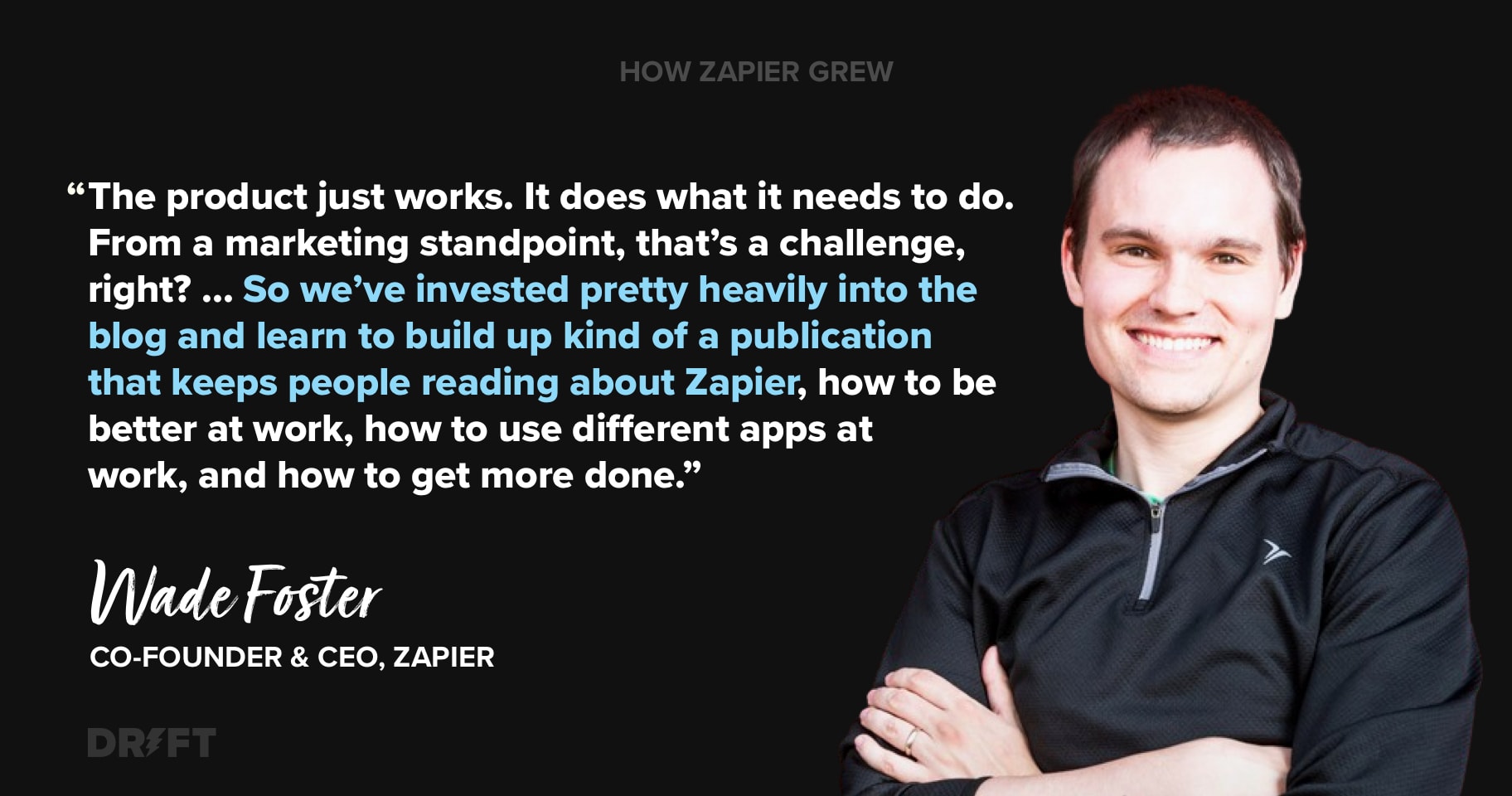
Today, the Zapier blog receives more than a million unique visitors each and every month.
Final Thought
Zapier is continuing to prove itself as a tech powerhouse. This year, the company placed 24th on Forbes’ annual Cloud 100 list, which ranks the world’s top private cloud computing companies. And while Zapier’s customer-centricity, transparency, and work ethic, have helped propel the company to where it is today, their actual product offering – automation – has them poised for longevity.
Businesses are doubling-down on digital transformation and recognizing the power of automation. In fact, McKinsey estimates that automation could increase global productivity growth by up to 1.4% annually. As Wade notes:
“Automation is one of the most pivotal topics of the next decade. People and businesses are proactively seeking smarter, better ways to drive tangible results in less time…we’re able to give businesses of all sizes valuable time back in their day so they can focus on their most important goals.”
Which means Zapier will continue to be a behind-the-scenes necessity for businesses.
Need a quick recap of what we just covered? Look no further:
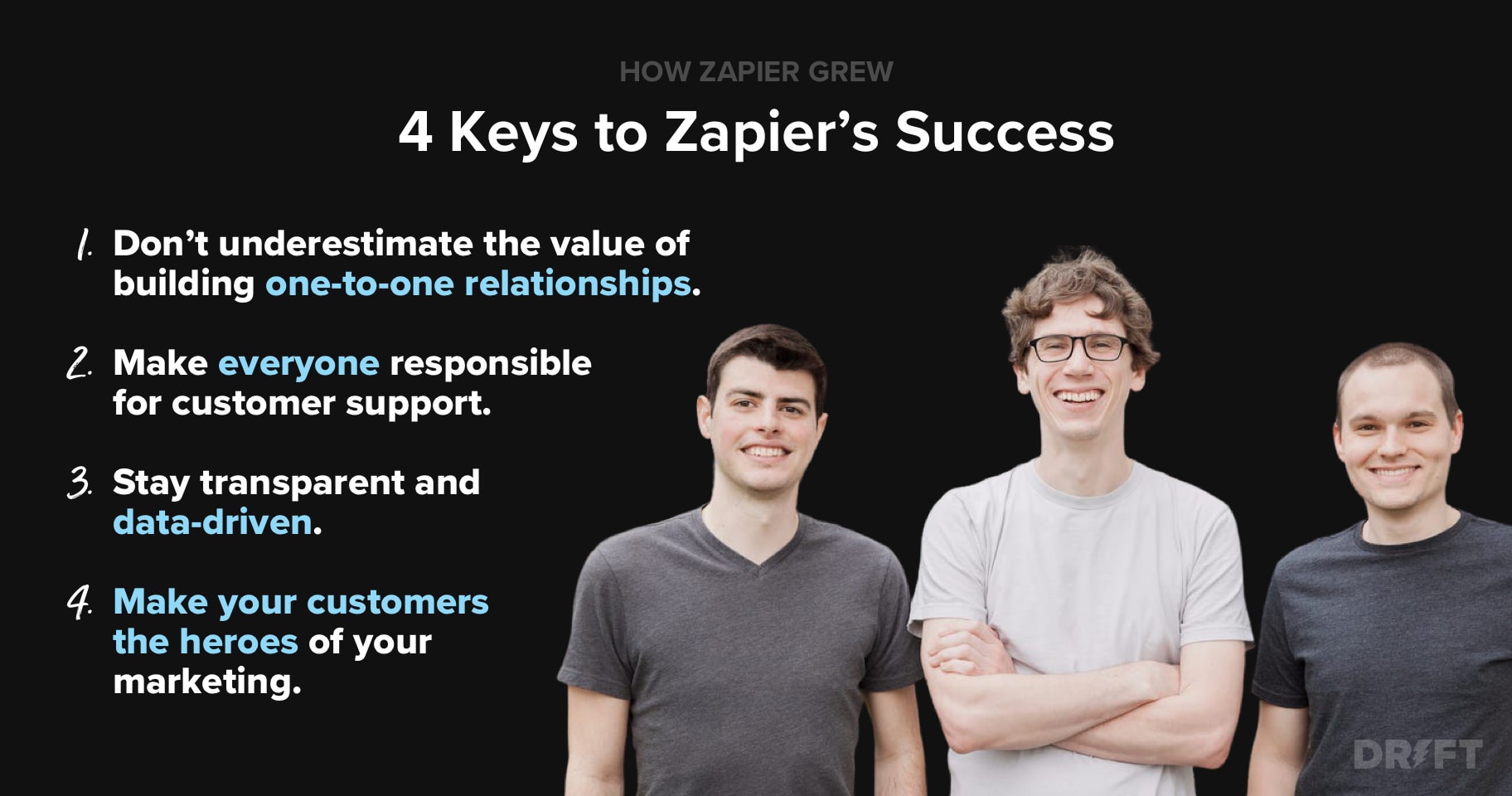
Want to drive Zapier-level growth for your business? Start here.
Editor’s Note: This article was published in February 2019 and has been updated to reflect new information.









